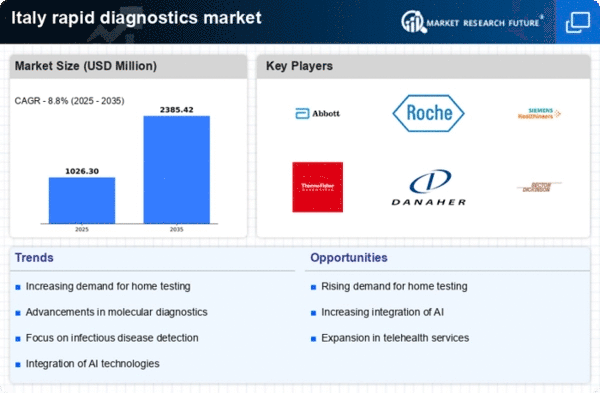Supportive Regulatory Environment
The regulatory landscape in Italy is becoming increasingly supportive of innovations in the rapid diagnostics market. Regulatory bodies are streamlining approval processes for new diagnostic tests, which encourages research and development in this sector. This supportive environment is crucial for fostering innovation and ensuring that new diagnostic solutions reach the market swiftly. Recent initiatives by the Italian Medicines Agency (AIFA) aim to expedite the evaluation of rapid diagnostic tests, thereby enhancing their availability to healthcare providers and patients. As a result, the rapid diagnostics market is likely to experience accelerated growth, driven by the introduction of novel diagnostic tools that meet regulatory standards and address the needs of the healthcare system.
Rising Consumer Awareness and Demand
Consumer awareness regarding health and wellness is significantly impacting the rapid diagnostics market in Italy. As individuals become more informed about their health, there is a growing demand for accessible and reliable diagnostic solutions. This trend is particularly evident in the increasing popularity of home testing kits, which allow consumers to monitor their health conveniently. Market Research Future suggests that the home testing segment is anticipated to grow by 15% annually, reflecting a shift in consumer behavior towards proactive health management. This heightened awareness is prompting manufacturers to innovate and expand their product offerings in the rapid diagnostics market, catering to the evolving needs of health-conscious consumers.
Growing Prevalence of Chronic Diseases
The rising incidence of chronic diseases in Italy is a pivotal driver for the rapid diagnostics market. As the population ages, conditions such as diabetes, cardiovascular diseases, and respiratory disorders become more prevalent. This trend necessitates timely and accurate diagnostic solutions to manage these health issues effectively. According to recent data, chronic diseases account for approximately 80% of healthcare costs in Italy, underscoring the urgent need for rapid diagnostics. The ability to quickly identify and monitor these conditions can lead to better patient outcomes and reduced healthcare expenditures. Consequently, healthcare providers are increasingly investing in rapid diagnostic tools to enhance disease management and improve patient care, thereby propelling the growth of the rapid diagnostics market in Italy.
Technological Integration in Healthcare
The integration of advanced technologies in healthcare is transforming the rapid diagnostics market in Italy. Innovations such as artificial intelligence, machine learning, and telemedicine are enhancing the accuracy and efficiency of diagnostic tests. These technologies enable healthcare professionals to analyze data more effectively, leading to quicker decision-making processes. For instance, AI-driven diagnostic tools can process vast amounts of data to identify patterns that may not be immediately apparent to human analysts. This technological evolution is expected to increase the adoption of rapid diagnostic solutions, as healthcare providers seek to improve patient care and operational efficiency. The market is projected to witness a growth rate of approximately 12% annually, driven by these technological advancements.
Increased Focus on Preventive Healthcare
There is a notable shift towards preventive healthcare in Italy, which significantly influences the rapid diagnostics market. This paradigm shift emphasizes early detection and intervention, aiming to reduce the burden of diseases before they escalate. The Italian government has been promoting health awareness campaigns that encourage regular screenings and check-ups. As a result, the demand for rapid diagnostic tests that facilitate early disease detection is on the rise. Market data indicates that the preventive healthcare segment is expected to grow at a CAGR of around 10% over the next five years. This trend not only enhances patient health outcomes but also reduces long-term healthcare costs, thereby driving investments in the rapid diagnostics market.






















Leave a Comment